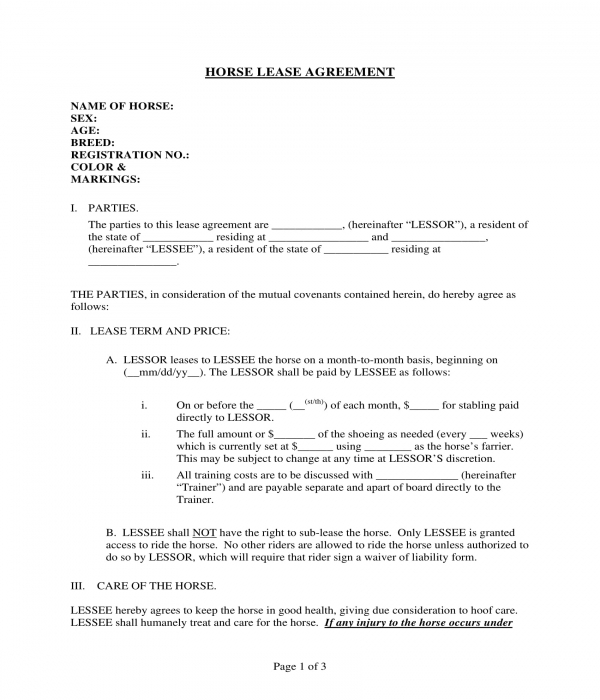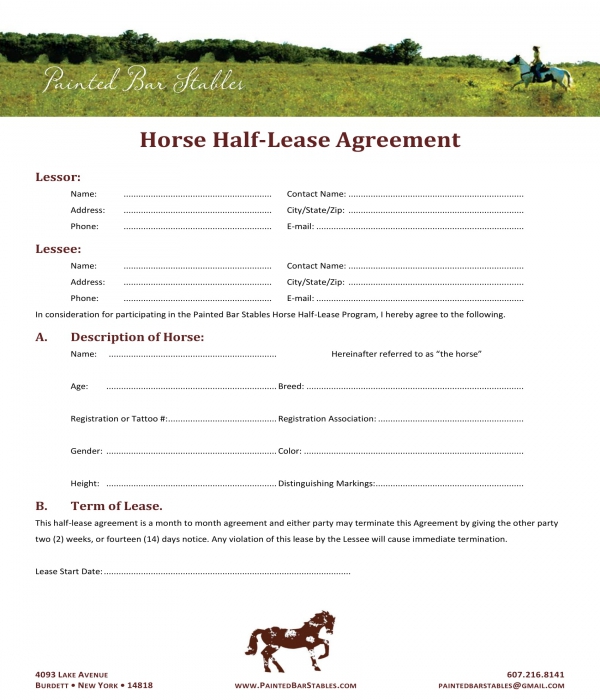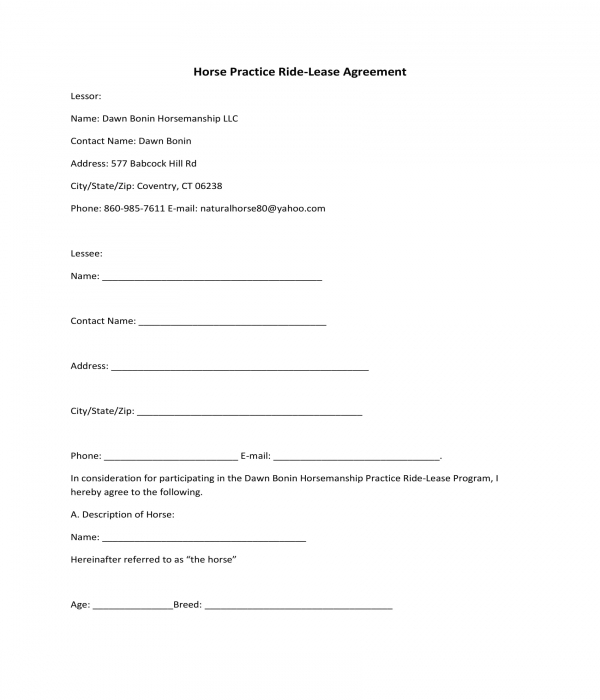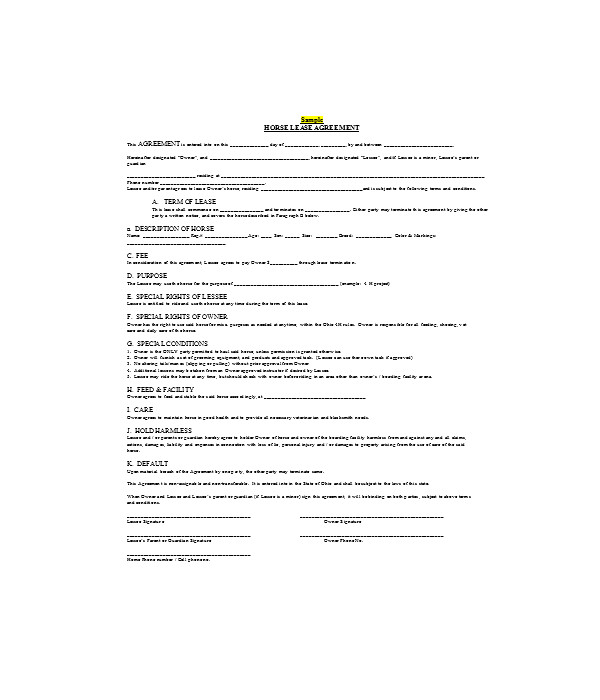Cars and trucks may be the machines which are used nowadays for transportation services, but in the olden times, horses are the ones who are the pets and the vehicles of their owners. However, in today’s generation, horses are no longer used as a means of transportation rather for races, equestrian lessons, and other intentions in relation to learning more about the animal itself. This is why there are organizations and horse-owners who opt to lease out their horses for those who are inclined and interested in learning horseback riding and other activities. You may also find horse forms.
Horse Lease Agreement Form
What Is a Horse Lease Agreement Form?
A horse lease agreement form is a document which is used by horse-owners who want to lease out their horses. In the form, the lessor and the lessee will be able to communicate their needs, wants, and expectations for the lease. By using the form, anticipated payments and issues will be addressed in order to inform both parties along with their individual obligations and responsibilities to ensure that the terms of the lease will be executed within the lease period or duration.
Varieties of Horse Lease Agreement Forms
Horse lease agreement forms can have several varieties which depend on the type of horse lease which is offered by the owner and accepted by the lessee. Below are two of the most common varieties of horse lease agreement forms that parties to a horse lease can use:
- Horse Half-Lease Agreement Form – When in a full lease, the lessor and the lessee are both agreeing on leasing a property for a specific period until the end date of a lease. However, when it comes to signing half-leases, the lessor is only allowing the lessee to use the property for specific days of the week with a specified number of hours per day.
- This is also applicable for horse half-lease agreements wherein the lessee can ride the horse only during the days stated in the agreement contract. By having a half-lease, the lessor will be able to save more on the expenses for taking care of his horse especially if he will be away and will want a carer for the meantime until his arrival.
Horse Half-Lease Agreement Form
- Horse Practice Ride-Lease Agreement Form – This variety of horse lease agreement form is intended to be used by lessors who lease their horses for the sole purpose of horse practice riding programs. The client who is the rider of the horse will be the lessee of the agreement. The horse practice ride-lease agreement form will firstly collect identify the parties to the lease along with their contact information and address.
- Then, the horse’s description is required to be stated in the second portion of the form such as the horse’s name, breed, and other properties of the horse which will identify it as the animal to be leased out. The succeeding contents of the agreement center on laying out the term of the lease, provisions, entitlements, and sole ownership statements.
Horse Practice Ride-Lease Agreement Form
How to Create a Basic Horse Lease Agreement Form
Creating a horse lease agreement form is easy if both parties will communicate their points, views, opinions, and necessities. Also, both parties should be aware of the legislation and regulations of the State or country where the lease will be used to ensure that the terms and statements in the document are legally accepted. Nonetheless, below are the steps to aid anyone in a lease in creating the agreement form which will be needed for leasing out a horse:
Step 1: Name the document.
The name or the title of the document will serve as an introduction to the leasing parties. Some horse lessors also incorporate their organization logo at the topmost corner of the form which signifies who the preparer and the owner of the document is. Other contents which can be included along with the name and the logo are areas for the date of when the form is used and for the sequence or assignment number of the document for easier identification of the document, especially when providing a client payment receipt and in enclosing other related paperwork.
Step 2: Make fields for the horse information section.
The horse information section of the form should be able to identify the horse’s name along with the descriptions of its breed, sex, age, colors, and special markings as well as the horse’s registration number.
Step 3: Allocate an area for identifying the parties involved.
This section will state the names of the lessor and the lessee with their residential information. A common statement used for this section is “The parties to this lease agreement are…” which will determine who the lessor and the lessee will be.
Step 4: Define the lease term and pricing.
The specific data to be defined in this section are the dates of when the lease will be executed and when it will be terminated along with the price associated with the lease. Additionally, how the lease payment will be provided by the lessee is also included in this section which can vary from monthly basis or annually depending on what both parties have agreed on for their financial responsibilities. Moreover, the lessor can also incorporate details of training session fees and other payments, including the processing fee, the horse care fees, and others which should be fulfilled by the lessee as he leases the horse.
Step 5: Enlist the horse care requirements.
This section is significant to be properly enlisted and described in the form to ensure that the lessee knows what she is allowed and required to do to the leased horse. For instance, the lessee will be obligated to take care of the veterinary service payments in the event that the horse is injured within the duration of the lease. Another example of horse care requirements which can be included in this section is the responsibility of the lessee to contact the lessor immediately to report about the horse’s medical information and status.
Step 6: Incorporate a limitation of liability.
To ensure that the lessor will be protected from unexpected expenses accompanying a lessee’s recklessness in riding the leased horse, a limitation of liability statement or a liability release waiver condition must be included in the form. This statement is essential for waiving the rights of the lessee in suing or demanding from the lessor specifically in events of accidents.
Step 7: State remedies for breach.
A breach of contract refers to the actions of one party which are deemed as unlawful and have passed the boundaries or conditions stated in the agreement form. To anticipate a breach allows both parties to know what the penalties will be and how the issues will be addressed immediately. One of the common remedies for a contract breach is the termination of the contract or the agreement, and the mandatory requirement for the breaching party to provide a payment in association with the actions that he took causing the breach.
Step 8: Add representations and warranties.
In this section, the lessor will be able to make his pitch about the horse and what he can provide to the lessee such as the guaranty that the horse is in a favorable health condition and that the horse has not a single illness to be dealt with during the period of the lease. On the other hand, if the horse has a specific condition, the lessor should inform the lessee and serve the lessee with the horse’s current medical reports from the horse’s veterinary service provider. This section ensures that every bit of detail about the lease and the horse will be supplied to the parties involved and be recorded in the agreement.
Step 9: Include an acceptance statement.
An acceptance statement is for indicating that both parties have accepted the terms and conditions and all other inclusions in the lease agreement. With the statement, a signature block must be allocated for the signatures of the lessor and the lessee, and in addition, a witness of their agreement signing. The date of when the agreement was finalized and signed must also be specified and stated beside the signatures of the parties.
With the aforementioned steps, horse owners and lessors will be able to ensure that the agreement which will be crafted for the client is effective and will address every necessary concern which can arise during the period of the lease. Nevertheless, both parties must also keep the signed horse lease agreement forms and retain it until the lease ends.
Part Time Horse Lease Agreement Form
Simple Horse Lease Agreement Form
Benefits of Using Horse Lease Agreement Forms
There are tons of different benefits and advantages when crafting and using horse lease agreement forms. One of the benefits that a lessor and a lessee can evidently acquire is that both of them will be able to record legally what they have negotiated for the lease. This ensures that conflict will be minimized and remedied. Another benefit of using the form is that it determines what each party is required to fulfill as well as how they can meet each other’s needs, wants and the horse’s necessities.
Related Posts
-
Lease Renewal Form
-
FREE 10+ Sample Lease Extension Forms in PDF | Word | Excel
-
FREE 9+ Sample Commercial Lease Agreement Forms in PDF | Word
-
FREE 11+ Sample Rental Lease Forms in MS Word | PDF | Excel
-
FREE 9+ Sample Commercial Lease Forms in PDF | MS Word
-
FREE 7+ Sample Month to Month Lease Forms in PDF | MS Word
-
FREE 7+ Sample Residential Lease Forms in PDF | MS Word
-
FREE 8+ Sample Apartment Lease Forms in PDF | MS Word
-
House Rent Allowance Form
-
Rent Roll Form





